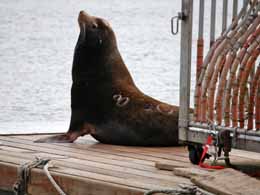forum
library
tutorial
contact

Study: Seals, Sea Lions Eating More
Columbia River Salmon Than Previously Thought
by Tom Paulu
The Daily News, November 6, 2014
|
the film forum library tutorial contact |

|
Study: Seals, Sea Lions Eating More
by Tom Paulu
|
 Seals and sea lions are killing even more adult salmon in the Columbia River than previously thought, according to a federal fisheries agency.
Seals and sea lions are killing even more adult salmon in the Columbia River than previously thought, according to a federal fisheries agency.
Preliminary results of research by the National Marine Fisheries Service that began in 2010 show a steady increase in fish mortality over a five-year period that may be attributable to seals and sea lions. Adult salmon returning from the ocean to the Columbia River Basin are being killed by seals and sea lions between the estuary and Bonneville Dam in "alarming numbers," according to the agency.
This year, the average spring Chinook salmon survival was just 55 percent, down from 69 percent in 2013 and 82 percent in 2012, according to a news release from the Northwest Power and Conservation Council. This means approximately 45 percent of the 2014 spring Chinook run died somewhere between the mouth of the river and Bonneville Dam, in addition to those taken by fishermen.
"Even I have a hard time believing those numbers, but at least through 2013, estimates of fish mortality do fall within theoretical estimates of predation," lead researcher Dr. Michelle Wargo-Rub said in the release. Wargo-Rub presented the information to the council's Fish and Wildlife Committee this week in Portland.
Wargo-Rub said fish mortality, and the number of sea lions in the Columbia River estuary, have increased dramatically in recent years. NOAA research focuses on spring Chinook because that is the time of year when the sea lion population is largest in the river. Sea lions also eat sturgeon, though that species wasn't addressed in this study.
The number of sea lions observed at haul-out sites near Astoria by Oregon Department of Fish and Wildlife Tom Paulu increased from 72 in 2011 to 616 this year.
This year, sea lions ate 4,746 salmon and steelhead at Bonneville Dam, which is higher than the past three years. Though sea lions are monitored extensively at the dam, researchers don't know how many salmonids are munched farther downstream. However, an ODFW marine mammal researcher earlier this year told the Oregonian that the fish kill at the dam is "a very, very minimal estimate of the total loss" on the river.
In 2010, as many as 7,000 marine mammals -- 3,000 California and Stellar sea lions and 4,000 harbor seals -- were estimated to live in the Columbia and the nearby part of the ocean for all or part of the year. Ninety percent of those were thought to live in the lower river and estuary.
Mostly males, the sea lions follow the spring-returning fish between March and May. Most of the sea lions then go to breeding grounds off southern California in the summer.
Wargo-Rub and her research team catch and tag salmon in the estuary near Astoria. More than 2,200 salmon have been tagged since the research project began, and of those about 68 percent were determined by genetic testing to be destined for the river and tributaries above Bonneville. Survival varies over the course of the run, Wargo-Rub said. It appears that a higher proportion of early-migrating fish die before reaching Bonneville Dam than fish that migrate later in the spring. Early returning fish also take longer to reach the dam and so are exposed to potential predation for a longer time, she said.
In the news release, Phil Rockefeller, a Washington member of the Power and Conservation Council, pointed out that the council's Columbia River Basin Fish and Wildlife Program calls on federal agencies to use their authorities to reduce predation losses caused by seals and sea lions. The council has also called for federal funding of additional research to determine how many salmonids, sturgeon and lamprey are being eaten by sea lions and seals from Bonneville Dam to the Columbia River mouth.
Since 2008, Washington and Oregon have been trapping and killing California sea lions at the dam. Fifteen were trapped this year. The trapping program has been controversial and was the subject of an unsuccessful law suit from the Humane Society of the United States. There's even a Facebook page called "Save the Bonneville Sea Lions."
learn more on topics covered in the film
see the video
read the script
learn the songs
discussion forum
